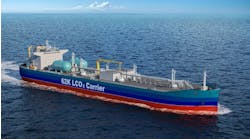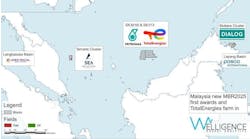Buying or leasing FPSO units driving allocations
- Aker H-3 semisubmersible accommodation unit Borgland Dolphin arriving at the Harland and Wolff yard in Belfast last month. It will be converted for drilling in preparation for a long term charter by Statoil in the Norwegian North Sea, reflecting the buoyant mood in the new low-cost Norwegian sector. [42,125 bytes]
- Saga's Snorre production platform is one of a number of established Norwegian installations with potential for lower cost subsea tiebacks. [13,027 bytes]
Furthermore, the North Sea's most expensive operations sector tag looks to have passed to the UK, where average costs are rated nearly a dollar per boe higher at $5.1/boe. That figure, however, reflects a surge in the use of leased FPSOs in the UK North Sea - effectively a shift away from capital to operating expenditure.
Prior to Norsok, a number of factors were driving Norway's operational cost burdens. Chief among these were the startup of the Statpipe trunkline which imposed high third party tariffs, the oil price collapse of the mid-1980s, and the introduction of a carbon dioxide tax for Norwegian field operations in 1991.
Factors reversing this trend include the abolition of gas royalties by the government in 1992, the streamlined designs for the new generations of large platforms and floating production units recently brought onstream in the Norwegian sector, and increased subsea activity from some of the older facilities.
Wood Mackenzie forecasts a further slight reduction in opex (operating expenditures) through to 1999, followed by a small upsurge from 2000 as large scale gas production starts up from a batch of fields in Mid-Norway, where newly installed trunklines will again attract higher tariffs for third party transportation.
Tax review
In the UK, the new Labor government could also influence project costs, depending on the outcome of its recently announced review of the oil and gas fiscal regime. It stated that it wanted to "ensure a (appropriate) share of profits are taxed while a high level of oil industry interest in the future development of reserves is maintained".New Labor purports to be the private sector's friend, in contrast to the tax-happy image of Old Labor, which last governed Britain in the 1970s. In those days, however, North Sea oil and gas was in its infancy and oil prices were twice today's levels, so the two administrations cannot be compared. However, Frances Gugen of Amerada Hess was somewhat apprehensive in his address as Crine Network chairman at Offshore Europe this September.
While welcoming the government's statement that the review of fiscal policy would be open, rather than imposing arbitrary changes, he pointed out that over 330,000 jobs in the UK were dependent on the offshore industry. Suppliers and contractors are now having to contend with a high value pound dampening export potential, allied to increased oil and gas development opportunities throughout the globe.
"It would be tragic," Gugen added, "if higher taxes were to divert investment funds, depress the oil and gas industry, and rob it of a golden chance for export-led growth and employment."
Wood Mackenzie says the key for the new government will be to ensure that any fiscal changes do not depress the level of business in the UK. In real terms, it points out, nearly £135 billion has been invested by oil companies in the UK offshore sectors, with an additional £4 billion annually for exploration and appraisal and operating costs.
However, recent UK field developments have averaged 70 million boe, compared to 150 million boe in parts of the Far East and 550 million boe onshore Colombia. Stability and cordial relations with the authorities, which have kept some oil companies in Britain, are no longer of overriding importance as the industry learns how to wield its influence even in the world's most dubious regimes.
Investment returns from UK sector projects will likely remain high for a few more years, but Labor has to bear in mind that this is a mature province. And as Wood Mackenzie points out, oil companies may come to regard the UK as a low risk cash generator, concentrating on maximizing returns from their mature field assets rather than pouring money into deepwater Atlantic wildcats.
Another New Labor initiative has been to bring forward compulsory environmental impact assessments for any oil and gas activity expected to produce 500 tons of oil or 500,000 cu meters per day of gas, as well as any newly installed offshore pipelines over 40 km long and over 0.8 meters in diameter. This is in line with a new European Union directive which was not due to be applied in Britain until 1999.
Energy and Industry Minister John Battle commented: "I want Britain to lead in offering public access to this environmental information so that people can see and judge for themselves the performance of the industry when it plans a project." Public accountability is an often reiterated component of New Labor's approach to government.
However, there has been no openly adverse comment so far from the UK oil industry. Conoco UK chairman Dr. George Watkins, speaking recently in London about Atlantic Frontier exploration, said: "Like the government and the rest of the oil industry, we see the Atlantic Margin as a legitimate area for exploration and development, properly licensed and subject to stringent standards with which we are happy to comply."
Environment Minister Michael Meacher also hinted in September that the government was moving away from disposal of redundant oil and gas installations at sea in favor of land-based disposal - except in instances such as heavy concrete structures or damaged platforms that would be too dangerous to dislodge.
This is good news for the crane barge specialists and the new legion of contractors dismantling their cargoes of platforms on land. But it may also abort some oil companies' plans for new types of fixed platforms in Britain's deeper waters.
The previous month in Stavanger, speaking at the Environment Northern Seas conference, Heinz Rothermund, managing director of Shell UK Expro, underlined the paradoxes involved in removing even small installations such as Shell's Leman BK gas platform from the seabed. The cost for a cleaner seabed in this case, he pointed out, was to consume 127,000 gigajoules in energy in the process of extracting the platform, or 4 million liters of diesel fuel. That much energy would have satisfied London's entire electricity demand for six days, he claimed.
A study issued at the same conference by Prognos, the Basel-based European center for economic research and strategy consulting, suggested that imposing total removal of all redundant steel platforms in the North Sea over the next 23 years could cost European taxpayers an additional $400 million to $2,200 million. Which would be equivalent to investing annually in 10-50 windpower generators to supply up to 15,000 households with electricity.
Copyright 1997 Oil & Gas Journal. All Rights Reserved.


